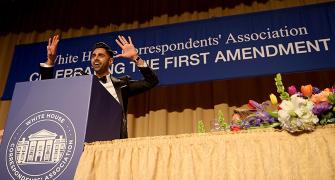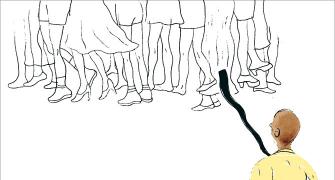It turns out that there is serious money in funny business these days!
Veer Arjun Singh examines the change.
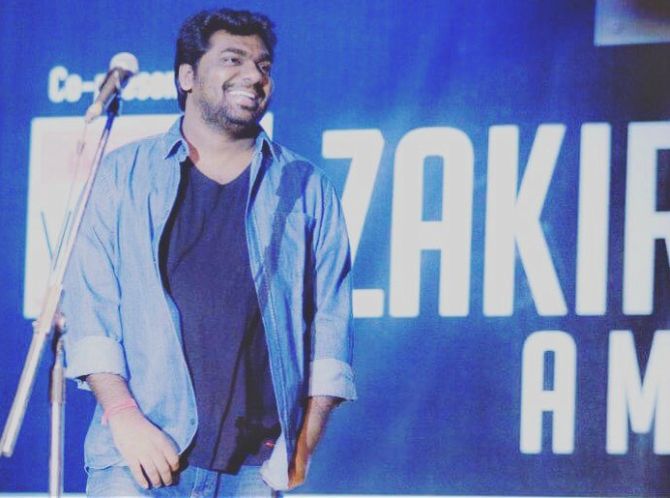
He has sold out four back-to-back venues in just a month.
Photograph: @Zakirism/Twitter.
'Good night, ladies and gentlemen, my name is…' The rest of it is drowned in the thunderous applause of a packed auditorium.
Walking towards the exit gates, the clamorous chatter is all about hurting jaws and stiff bellies from hours of laughing. When India's finest comics hold a mic and own the stage, the ones subjected to their wisecracks leave feeling even more special.
Their jokes might be forgotten but the names will be remembered -- then Googled and searched on YouTube for videos that will be watched incessantly at home and at work, and thereafter shared on social media.
The art of selling humour has existed in India for decades, but stand-up comedy was once the sole preserve of the West.
The likes of Dave Chappelle, Louis CK and Russell Peters are watched the world over. Hollywood scripts are obsessed with Kevin Hart, Adam Sandler, Chris Rock and many others who started out as stand-up comedians.
In the past few years, Indian stand-ups have disrupted that monopoly.
Away from the world of slapstick comedy playing on TV, they are turning humour into a serious -- and nuanced -- business.
They come with evolved worldviews, keen observations, exhaustive memories and boundless energy.
They bring the unmentionable out in the open -- sex, rape, abortion, homosexuality.
They pick on politicians and godmen, cuss in Hindi, categorise people in white, brown and black, dis Donald Trump and Kim-Jong Un in the same breath, roast celebrities, make memes, and script comic sketches on corruption, nepotism, GST and demonetisation.
In their own lives, they have learned more than just to dodge death threats for "hurting Indian sensibilities".
Comics aren't born. They are booed, broken and tested till they are burnished.

While there are young comics, like Abhishek Upmanyu and Zakir Khan, who have taken the stage by storm in next to no time, there are also those like Khatri who have quit lucrative careers to become successful comics.
Photograph: @hornysindhi/Facebook.
For a stand-up comedian, it all begins with an open mic: the nights organised for amateurs to test their scripts and skills.
The inattentive, rambunctious populace of bars and comedy clubs is their harsh laboratory. If you survive a few times, you might slowly build your audience and find your comic voice.
"We've all been there. If you can learn to be belittled a hundred times and still come back on stage to win an audience, then you're made for it," says Karan Talwar, who is part of a collective of comics called SnG Comedy, formally known as and pronounced "Schitz n Giggles".
"Had to simplify the name; too many people mispronounced it," he says.
Talwar has spent close to a decade in the business. He says all comics, without exception, have honed their skills through open mics.
Early in his career, actor and stand-up comedian Vir Das, too, used to host an open mic called Hamateur Nights in Mumbai. The hugely popular comic act, who recently shot a special, Abroad Understanding, for Netflix in the United States and India, says he was once booed off a stage in 17 seconds at an open mic in Amsterdam.
A lot of comics credit him for the expansion of the industry.
"I was only looking to exploit young talent for money," Das quips in one of the podcasts with Talwar and the SnG crew.
And there's no dearth of either -- talent or money.
Many amateurs have day jobs and perform in the evenings after work.
"That's the beauty of stand-up comedy; it's a night business," says Talwar.
While there are young comics, such as Abhishek Upmanyu and Zakir Khan, who have taken the stage by storm in next to no time, there are also those who have quit long-time careers and lucrative jobs to become successful comics. Atul Khatri, for example, is 49 and Jeeveshu Ahluwalia has just turned 40.
It doesn't matter if you're 18 or 50, wear baggy jeans or sharp suits -- as long as you can draw a crowd.
But the grind is long and strenuous.
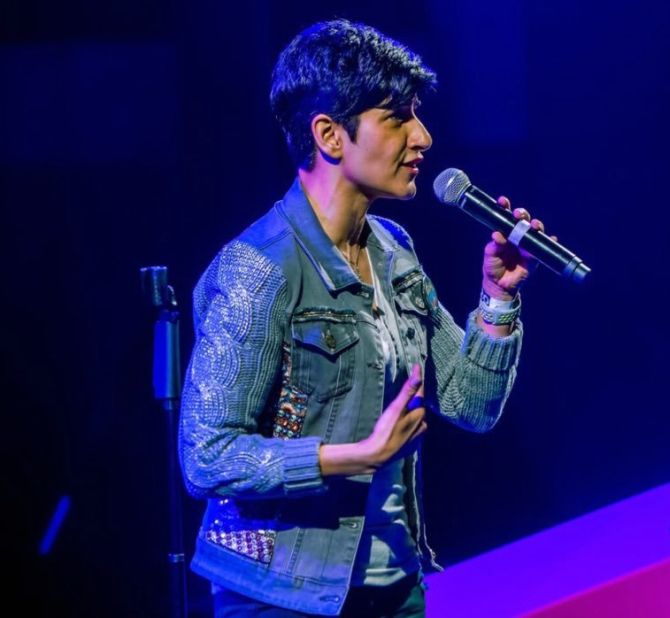
Photograph: @neetipalta/Twitter.
For most, early pay checks are abysmally low.
"I have performed in a living room for ₹600," says Ahluwalia, who quit as a director in operations after working for 14 years at Genpact in Gurugram.
His rags-to-riches story is straight out of a movie.
"I used to be a torch guy at movie theatre PVR Anupam in New Delhi where I was caught selling tickets in black and was thrown out. Then I joined Pizza Hut and delivered pizzas for three years before joining Genpact," says the man who has just bought himself a mansion in Gurugram. "I had promised myself a house before I turned 40."
Khatri was CEO of Kaytek Computer Services and in the IT business for 25 years before he ventured into comedy as a hobby.
As a comic, he has a packed schedule for the next few months, travelling from Hong Kong and Malaysia to West Asia and then to the US. His move was, perhaps, not as dramatic as he held both his jobs for four years before quitting his business last year to focus on his career as a comic.
"I didn't get paid the first year. It's not a stable career when you start," says Khatri.
But when it does take off, there's no looking back.
From amateur and private live shows, the natural progression for a stand-up comic is to get corporate shows.
For both new entrants and seasoned comics, this is one revenue stream that pays consistently. Comics make anywhere between ₹50,000 and ₹10 lakh at one corporate show, depending on their popularity.
Neeti Palta, who expresses raw feminist humour and rolls with it, recently did a corporate show for Max Hospitals that paid her about ₹2 lakh.
Speaking from the Bengaluru Comedy Festival, she highlights the perks, "Once I was flown down to Bali for a couple of days and was paid to do what I love doing."
Abish Mathew, widely known for AIB, speaks from the sets of a new special he's shooting for Amazon Prime. He relives the story of his first corporate event, which he describes as a scam he was pulled into.
"I did that show for free. I was lured with words like 'good publicity' and 'future contacts'. The show went well," says Mathew, "but I got no work calls for the next three months."
Almost all comics unanimously declare that corporate shows feature the most uninterested and hard-to-please audiences. "But I love the challenge and the payment-to-effort ratio," says Mathew.
Once a comic becomes a recognisable name, earnings start flowing in from different channels. And then time becomes money.
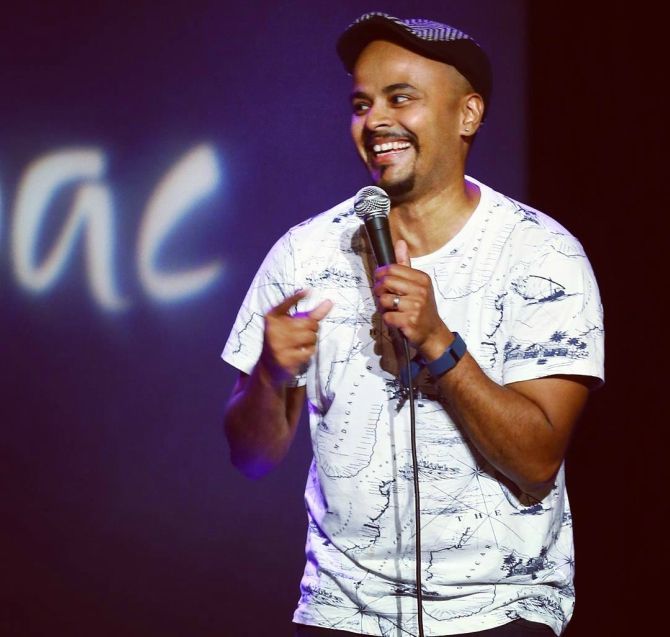
Photograph: @sorabhpant/Instagram.
Comics are also that unfortunate bunch of talented people who can't live off their popularity. They are jugglers who must suppress their personal lives to check the boxes of their work calendars.
"Let me give you an idea about my life as a comedian," says Sorabh Pant, who founded East India Comedy and has a comedy special called Rant of the Pant.
He has just landed in Jaipur from Mumbai for a corporate show. A day later he will fly to perform at the Bengaluru Comedy Festival, reach Kolkata for a public show the next day and, in between somewhere, will do a college show and launch his third novel in Pune.
"The job keeps us in transit. The little time I get, I spend with my kids," he says.
The comic industry has seen unprecedented growth in the last two years.
Dedicated spaces like the Canvas Laugh Club, in Mumbai and Delhi, and The Comedy Club in Bengaluru run multiple stand-up shows virtually every day.
Vijay Nair, CEO and founder of Only Much Louder, says comics have three major sources of earnings: live shows (ticket shows and private), brand integration and content. The fourth, he says, is merchandise.
A media and talent management company, Only Much Louder exclusively represents most of the top comics, including Mathew, Talwar, Khatri, Khan and AIB.
"AIB puts up a design it thinks is cool and sells 5,000 to 10,000 t-shirts a day. Most of the merchandise is sold out in about two weeks," says Nair.
Live shows are a small part of the money. While tickets sell from ₹100 to ₹2,500, depending on the popularity of the artiste, brand integration pays the most.
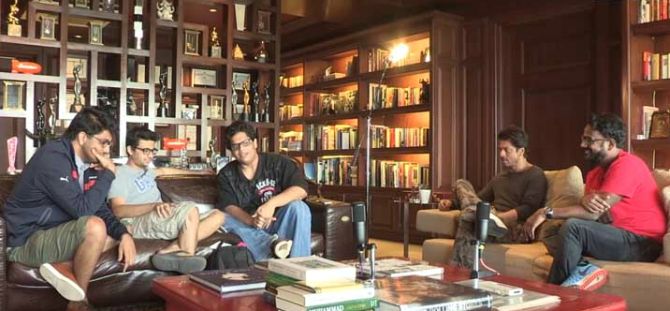
The enormous increase in content consumption over the internet in India is directly linked to a comic's revenue.
"We are not stand-ups anymore, we are more like content creators," says Talwar, who is writing a feature script on a break in Goa.
Ahluwalia did a cameo in Imtiaz Ali's Tamasha and Khatri, who has worked with Ranbir Kapoor and other actors for digital ads, is looking at a career in acting.
Many comics regularly write scripts for TV ads and awards shows such as the International Indian Film Academy awards.
The money they make from YouTube is insignificant compared to brand deals.
"It's $1,000 for a million hits on YouTube versus brand deals starting at ₹2 lakh for a young artiste and going up to over ₹1 crore for top-rung guys like AIB," says Nair.
AIB has expanded into an enterprise with full-time writers for its online content.
While Tanmay Bhatt leads a team of young writers for YouTube content, Gursimran Khamba heads a team of part-time writers for a web series.
This has thrown the floor open to young talent looking to explore careers in comedy writing.
Manaswi Mohata, a senior writer at AIB and former copywriter at Creativeland Asia, has been at it for the last two years, taking charge of YouTube projects that have featured actors such as Kangana Ranaut and other comics like Mallika Dua.
Most comics are bilingual.
Crass punches are better received in Hindi by audiences in all major metros in North India. But there's a curious divide between how English and Hindi humour sells.
"English comics can sell indoor venues of 1,000 to 3,000 seats. Someone like Zakir Khan, whose shows are mostly in Hindi, can sell stadiums. He has sold out four back-to-back venues in just a month," says Nair.
From the fresh crop, a young Jaspreet Singh who speaks English with a thick Punjabi accent and has just three stand-up videos on YouTube is travelling to Dubai for a solo show. The strictly English-speaking and better-known comic, Kenny Sebastian, has sold out shows in Nasik, Maharashtra.
The mic is open.

